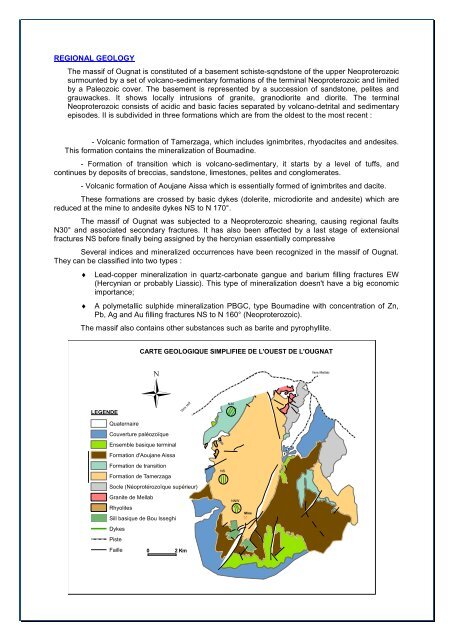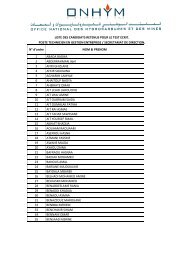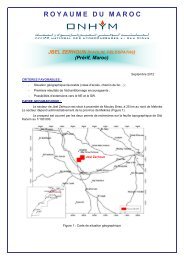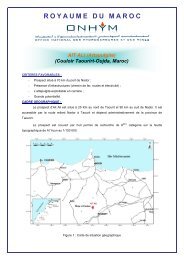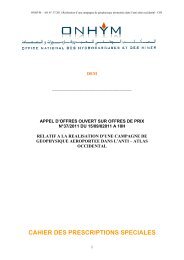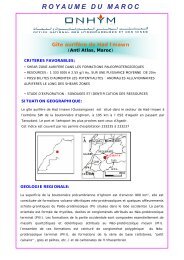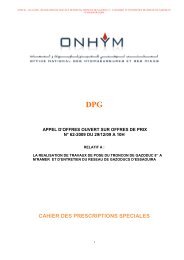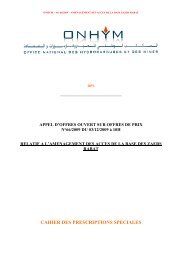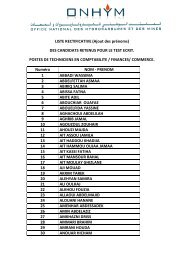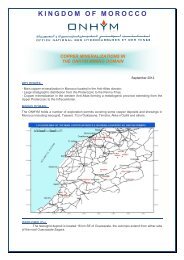K I N G D O M O F M O R O C C O
K I N G D O M O F M O R O C C O
K I N G D O M O F M O R O C C O
You also want an ePaper? Increase the reach of your titles
YUMPU automatically turns print PDFs into web optimized ePapers that Google loves.
Néoprotérozoïque<br />
terminal<br />
REGIONAL GEOLOGY<br />
The massif of Ougnat is constituted of a basement schiste-sqndstone of the upper Neoproterozoic<br />
surmounted by a set of volcano-sedimentary formations of the terminal Neoproterozoic and limited<br />
by a Paleozoic cover. The basement is represented by a succession of sandstone, pelites and<br />
grauwackes. It shows locally intrusions of granite, granodiorite and diorite. The terminal<br />
Neoproterozoic consists of acidic and basic facies separated by volcano-detrital and sedimentary<br />
episodes. II is subdivided in three formations which are from the oldest to the most recent :<br />
- Volcanic formation of Tamerzaga, which includes ignimbrites, rhyodacites and andesites.<br />
This formation contains the mineralization of Boumadine.<br />
- Formation of transition which is volcano-sedimentary, it starts by a level of tuffs, and<br />
continues by deposits of breccias, sandstone, limestones, pelites and conglomerates.<br />
- Volcanic formation of Aoujane Aissa which is essentially formed of ignimbrites and dacite.<br />
These formations are crossed by basic dykes (dolerite, microdiorite and andesite) which are<br />
reduced at the mine to andesite dykes NS to N 170°.<br />
The massif of Ougnat was subjected to a Neoproterozoic shearing, causing regional faults<br />
N30° and associated secondary fractures. It has also been affected by a last stage of extensional<br />
fractures NS before finally being assigned by the hercynian essentially compressive<br />
Several indices and mineralized occurrences have been recognized in the massif of Ougnat.<br />
They can be classified into two types :<br />
� Lead-copper mineralization in quartz-carbonate gangue and barium filling fractures EW<br />
(Hercynian or probably Liassic). This type of mineralization doesn't have a big economic<br />
importance;<br />
� A polymetallic sulphide mineralization PBGC, type Boumadine with concentration of Zn,<br />
Pb, Ag and Au filling fractures NS to N 160° (Neoproterozoic).<br />
The massif also contains other substances such as barite and pyrophyllite.<br />
LEGENDE<br />
Quaternaire<br />
Couverture paléozoïque<br />
Ensemble basique terminal<br />
Formation d'Aoujane Aissa<br />
Formation de transition<br />
Formation de Tamerzaga<br />
Socle (Néoprotérozoïque supérieur)<br />
Granite de Mellab<br />
Rhyolites<br />
Sill basique de Bou Isseghi<br />
Dykes<br />
Piste<br />
Faille<br />
CARTE GEOLOGIQUE SIMPLIFIEE DE L'OUEST DE L'OUGNAT<br />
Ü<br />
0<br />
Vers Isilf<br />
2 Km<br />
NS<br />
N30<br />
NNW<br />
Ç<br />
Mine<br />
Vers Mellab


